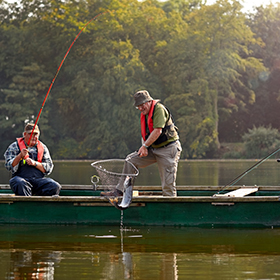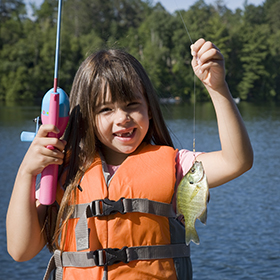Many are familiar with the concept of catch-and-release fishing, but few know the actual techniques anglers have to use in order to inflict as little damage as possible upon the fish.
Many are familiar with the concept of catch-and-release fishing, but few know the actual techniques anglers have to use in order to inflict as little damage as possible upon the fish. Read on to find out the best way to handle fish, what hooks to use for catch-and-release, and how to revive the fish if necessary.
Prepare Your Hooks
If you’re planning on practicing catch-and-release, stay away from treble hooks; the triple-pronged hooks will inflict too much damage on a fish you’re meant to be throwing back. Stick to j-hooks or circle-hooks instead. If you need to swap out the hooks on your bait, use a small pair of split-ring pliers to remove the treble-hooks. The pliers will also come in handy to de-barb your j or circle hooks; do this by “squishing’ the barb down so that it is flush with the tip of the hook. Ultimately, circle-hooks are the best choice for catch-and-release anglers as the circular shape of the hook can be passed through the fish’s stomach in the event that it is swallowed.
Handling the Fish
When you’ve hooked a fish you plan to release, keep in mind that a protracted battle with the fish could cause it to expire from the exertion of energy during the fight. When you’ve caught the fish, be sure to handle it with wet hands. Fish have a protective layer of “slime” that gets disturbed when handled with dry hands, leaving the fish vulnerable to infections. In the event that the fish gets hooked in its stomach, it is best to cut the line and leave the hook undisturbed, rather than attempting to remove it. Finally, never hold the fish by its lower lip with one hand, always use your other hand to support the belly and lessen the pressure on its jaw.
Fish CPR and Revival
Despite your efforts not to overtire the fish, your catch may be lethargic. In this scenario, it is best to perform fish CPR – don’t worry, it doesn’t require mouth-to-mouth! Hold the fish so that it is facing the current. This allows water to flow through its gills and encourages revival. If the water is fairly still, gently steer the fish in a figure-8 pattern in the water. Keep in mind that as soon as you release the fish, it returns to the food chain, so you want to be sure that you wait until it is showing signs of health and revival.
Fish provide anglers with untold hours of recreational fun, so the least we can do when practicing catch-and-release fishing is ensure that the fish is handled as gently as possible, thus giving it the best chance for survival long after we’ve left the lake! For more tips on catch-and-release fishing, read conservationist Joe Overlock’s article on Fix.com.
Content courtesy from Fix.com. Alexandra MacRae works for Fix.com, a lifestyle blog that covers all things fishing; from fly fishing to teaching children to fish.
Prepare Your Hooks
If you’re planning on practicing catch-and-release, stay away from treble hooks; the triple-pronged hooks will inflict too much damage on a fish you’re meant to be throwing back. Stick to j-hooks or circle-hooks instead. If you need to swap out the hooks on your bait, use a small pair of split-ring pliers to remove the treble-hooks. The pliers will also come in handy to de-barb your j or circle hooks; do this by “squishing’ the barb down so that it is flush with the tip of the hook. Ultimately, circle-hooks are the best choice for catch-and-release anglers as the circular shape of the hook can be passed through the fish’s stomach in the event that it is swallowed.
Handling the Fish
When you’ve hooked a fish you plan to release, keep in mind that a protracted battle with the fish could cause it to expire from the exertion of energy during the fight. When you’ve caught the fish, be sure to handle it with wet hands. Fish have a protective layer of “slime” that gets disturbed when handled with dry hands, leaving the fish vulnerable to infections. In the event that the fish gets hooked in its stomach, it is best to cut the line and leave the hook undisturbed, rather than attempting to remove it. Finally, never hold the fish by its lower lip with one hand, always use your other hand to support the belly and lessen the pressure on its jaw.
Fish CPR and Revival
Despite your efforts not to overtire the fish, your catch may be lethargic. In this scenario, it is best to perform fish CPR – don’t worry, it doesn’t require mouth-to-mouth! Hold the fish so that it is facing the current. This allows water to flow through its gills and encourages revival. If the water is fairly still, gently steer the fish in a figure-8 pattern in the water. Keep in mind that as soon as you release the fish, it returns to the food chain, so you want to be sure that you wait until it is showing signs of health and revival.
Fish provide anglers with untold hours of recreational fun, so the least we can do when practicing catch-and-release fishing is ensure that the fish is handled as gently as possible, thus giving it the best chance for survival long after we’ve left the lake! For more tips on catch-and-release fishing, read conservationist Joe Overlock’s article on Fix.com.
Content courtesy from Fix.com. Alexandra MacRae works for Fix.com, a lifestyle blog that covers all things fishing; from fly fishing to teaching children to fish.









